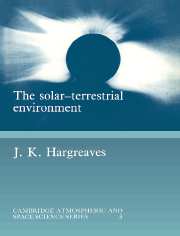 The Solar-Terrestrial Environment
The Solar-Terrestrial Environment Book contents
- Frontmatter
- Contents
- Preface
- 1 The Earth in space
- 2 The physics of geospace
- 3 Techniques for observing geospace
- 4 The neutral atmosphere
- 5 The solar wind and the magnetosphere
- 6 Principles of the ionosphere at middle and low latitudes
- 7 Ionospheric phenomena at middle and low latitudes
- 8 The ionosphere at high latitude
- 9 Magnetospheric waves
- 10 Technological application of geospace science
- Index
3 - Techniques for observing geospace
Published online by Cambridge University Press: 29 January 2010
- Frontmatter
- Contents
- Preface
- 1 The Earth in space
- 2 The physics of geospace
- 3 Techniques for observing geospace
- 4 The neutral atmosphere
- 5 The solar wind and the magnetosphere
- 6 Principles of the ionosphere at middle and low latitudes
- 7 Ionospheric phenomena at middle and low latitudes
- 8 The ionosphere at high latitude
- 9 Magnetospheric waves
- 10 Technological application of geospace science
- Index
Summary
When you can measure what you are speaking about and express it in numbers, you know something about it; but when you cannot measure it, when you cannot express it in numbers, your knowledge is of a meager, unsatisfactory kind.
Lord KelvinThe importance of observations
It would be difficult to overstate the importance of observational techniques in the development of the science of geospace.
Science is about the real world – the world which, most of us believe, exists outside ourselves and would continue to exist even if we were not here to see it. Our perception of that real world, however, is subjective and depends entirely on how we sense it, on the data we collect by eye or ear. This is equally true whether we observe directly, have the assistance of an instrument (telescope, ear trumpet), or take our information from the readings of a sensor (oven thermometer, particle detector on a spacecraft). The scientist's job is to make sense of such data, to fit them into existing knowledge, and to try to build up a coherent picture of the nature and working of the real, external world. Without observations we know nothing and can understand nothing. This is true of life in general and of science in particular.
The history of science plainly shows that new methods and novel techniques nearly always bring in their wake fresh advances of knowledge. Geospace is no exception. Of such an inaccessible region of the Earth we can learn very little without instruments, and the great expansion of knowledge during the last 50 years is a direct result of technological advance.
- Type
- Chapter
- Information
- The Solar-Terrestrial EnvironmentAn Introduction to Geospace - the Science of the Terrestrial Upper Atmosphere, Ionosphere, and Magnetosphere, pp. 44 - 97Publisher: Cambridge University PressPrint publication year: 1992


